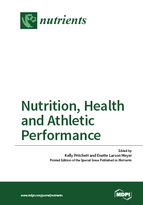Nutrition, Health and Athletic Performance
A special issue of Nutrients (ISSN 2072-6643).
Deadline for manuscript submissions: closed (31 August 2016) | Viewed by 538465
Special Issue Editors
Interests: sports nutrition; post exercise nutrition and recovery; carbohydrates and exercise; female athlete triad; energy availability; vitamin D and athletic performance
Special Issues, Collections and Topics in MDPI journals
Interests: the health and performance of active individuals, particularly women, at all stages of the lifecycle and at all levels of performance—from the casual exerciser to the elite athlete
Special Issue Information
Dear Colleagues,
Optimal nutrition is fundamental for enhancing training, recovery and performance in sport. Therefore, research has aimed to determine the efficacy of appropriate intake of nutrients, fluids, and supplements and their role in exercise performance. The purpose of this Special Issue entitled “Nutrition, Health and Athletic Performance” is to highlight recent research examining aspects of sports nutrition and exercise performance. Manuscript submissions of original research, meta-analyses, or reviews of the scientific literature, which targets nutritional strategies to benefit performance and health, are welcome. Studies performed in humans are preferred given the applied nature of this issue.
Dr. Kelly Pritchett
Dr. Enette Larson-Meyer
Guest Editors
Manuscript Submission Information
Manuscripts should be submitted online at www.mdpi.com by registering and logging in to this website. Once you are registered, click here to go to the submission form. Manuscripts can be submitted until the deadline. All submissions that pass pre-check are peer-reviewed. Accepted papers will be published continuously in the journal (as soon as accepted) and will be listed together on the special issue website. Research articles, review articles as well as short communications are invited. For planned papers, a title and short abstract (about 100 words) can be sent to the Editorial Office for announcement on this website.
Submitted manuscripts should not have been published previously, nor be under consideration for publication elsewhere (except conference proceedings papers). All manuscripts are thoroughly refereed through a single-blind peer-review process. A guide for authors and other relevant information for submission of manuscripts is available on the Instructions for Authors page. Nutrients is an international peer-reviewed open access semimonthly journal published by MDPI.
Please visit the Instructions for Authors page before submitting a manuscript. The Article Processing Charge (APC) for publication in this open access journal is 2900 CHF (Swiss Francs). Submitted papers should be well formatted and use good English. Authors may use MDPI's English editing service prior to publication or during author revisions.
Keywords
- carbohydrate
- protein (synthesis)
- performance
- glycogen (resynthesis)
- exercise recovery
- ergogenic aids/supplements
- hydration
- pre-exercise feeding
- athletes
- nutrition for training
- vitamins and minerals
- fat (metabolism)








